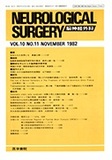Japanese
English
- 有料閲覧
- Abstract 文献概要
- 1ページ目 Look Inside
I.はじめに
頸椎の外科は到達法により,前方,後方,さらに側方からのアプローチがあり,どの方法をとるかは主病変が頸椎のどの部位にあるかによって決められる.頸椎を解剖学的見地からみると,頭蓋骨と脊椎との接合部を形成し,椎間板が介在せず,それぞれ特異な形態を持つ上位頸椎(環椎と軸椎)と,脊柱の頸部を構成する下位頸椎(第3-7頸椎)に分けられる.著者に与えられたテーマは"頸椎の手術"で,本来ならばこの頭蓋-頸椎接合部の上位頸椎と下位頸椎のさまざまな病変について,それぞれの前方,後方,側方よりの手術法を検討すべきであろうが,本稿ではCloward1), Smith & Robinson6)により開発されて以来,頸椎の代表的な手術法となった前方到達法について,頸部脊椎症を例にとり,われわれが行っている方法を詳述する.
なお,頸椎のみならず脊椎の手術を手掛ける時,その解剖を熟知することは当然であるが,脊椎は脊髄を保護していると同時に,躯幹を支持,かつ運動器官であることに留意し,脊椎の手術に伴ってその安定性(stability)が損なわれないよう,脊椎の生体力学を十分に理解しておかねばならない.
Surgical anatomy of an anterior approach to the cervicalspine, together with osteophytectomy for cervical spondylo-tic radiculomyelopathy, was described. Recognition offascial compartments is important to avoid unnecessaryinjuries to the vital structures such as oesophagus, trachea,carotid artery and recurrent nerve. Detailed operative pro-cedures of microsurgical osteophytectomy removing all thecompressing components against the cervical cord andradicula was also described. Biomechanics of the cervicalspine must be borne in mind beforehand when cervical spineoperation is considered.

Copyright © 1982, Igaku-Shoin Ltd. All rights reserved.


